| | Background | Introduction | Research | Buyers and Processors | Summary | Return to Special Commodity Marketing page
,
Creeping red fescue (Festuca rubra) is a major crop grown for seed in the Peace River region of Alberta and British Columbia. Annually, 1000 to 1200 growers will harvest between 80,000 and 120,000 acres of creeping red fescue for seed. Annual production varies between 35 and 40 million lbs. of seed. Annual export sales of creeping red fescue are between $28 to $30 million CDN.

Creeping red fescue is primarily grown for use in the turf grass industry, going into lawn mixes with other turf grass species such as perennial ryegrass and Kentucky bluegrass. Due to its creeping ability, creeping red fescue tends to sod in quickly. It is used in grass mixtures for seeding lawns, golf fairways, pastures, and for soil conservation purposes. The majority of creeping red fescue seed produced is exported out of the country. The Peace River region continues to be the world’s largest producing area of creeping red fescue seed.
| 
| 
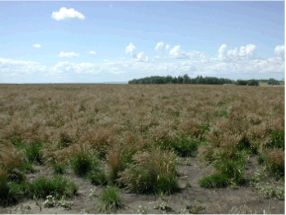
Creeping red fescue seed field outside of Clairmont, Alberta |
Creeping red fescue is originally native to the slopes of the Eastern Alps (Balkans region). However, the first seed to arrive in Canada originated in Czechoslovakia. In 1923, 100 lbs. of creeping red fescue seed were brought to Canada from Czechoslovakia, where 50 lbs. were distributed to golf courses in eastern Canada, while the remaining seed was brought to Alberta, and seeded at Brooks and Fenn, Alberta. Both Alberta seedings failed.
In 1931, another 100 lbs. were brought back to Canada, and distributed to four Agricultural Colleges located in Alberta: Vermilion, Oliver, Claresholm and Olds. Only the seedlings at Olds Alberta survived. Two growers in this Central Alberta area, Andrew Anderson and John Olson, began growing the crop in 1932. Subsequently, James Murray, an instructor at the Alberta School of Agriculture and Home Economics at Olds, developed a variety named “Olds”. “Olds” was developed from mass selection from the original Czechoslovakian stock. It exhibited strong creeping roots, drought tolerance, good hardiness, and was disease free.
In 1935, the first creeping red fescue seed arrived in the Peace country. Spence Morrison, an advisory officer with Alberta’s Department of Agriculture, brought two two-pound bags of creeping red fescue seed, along with some timothy seed, to the area. In June of 1935, Morrison left one two-pound bag at the Agriculture Canada Research Station at Beaverlodge. The other bag was left at Bainard Lake, where the crop failed.

Dr. Earl Stacey (left), with Les and Rowe Harris, in the first commercial field of Creeping Red Fescue grown
in the Peace River Region. Commercially seeded in 1939, this photo shows the 250 acre field in 1942.
The seed left at Beaverlodge immediately fell into the watchful eye of Dr. Earl Stacey, superintendent of the research station. Dr. Stacey convinced local farmers, Rowe and Les Harris (Harris Brothers farms), to seed the crop. In July of 1935, the first commercial crop of creeping red fescue was seeded on the old “McCarter place”, two miles south of Beaverlodge.
Over the next few years, the combined efforts of the Harris brothers, along with the experimental skills and supervision of Dr. Stacey, saw the potential of creeping red fescue as a seed crop develop. It was found that the Peace country’s long sunshine days and cool evenings were good for seed development. The crop was originally considered a valuable dual-purpose crop. Its’ herbage remained green well into the fall, extending the grazing season for cattle. As well, its’ ability to set seed enabled farmers to harvest the seed for cash purposes. The sod making abilities of the crop would also greatly improve the Peace’s grey-wooded soils.
The 1940’s
It was one thing to grow a crop, but it had to have a market. And with World War II came the Market! During the Second World War, it was discovered that creeping red fescue made a durable turf field, able to withstand heavy traffic and establish quickly. With airfields and army bases being constructed throughout the world to help with the war effort, a lot of seed was required. Exports of Canadian creeping red fescue seed increased dramatically as World War II continued.
From less than 100,000 lbs. exported in 1942, exports jumped to over three million two years later, and peaked at over five million lbs. in 1945. As the war ended, exports of creeping red fescue started to decline again. However, the performance of this grass during this period showed the world what fescue was capable of, as well as showed the world that the growers in the Peace Region could grow the crop.
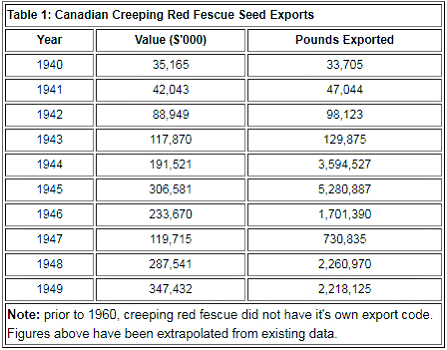
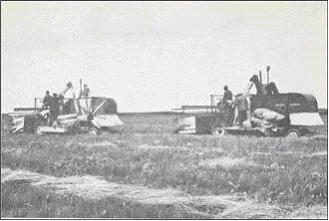
Two combines (Harris Brothers) harvesting creeping red fescue for seed.
Note: straight cut headers and bagging platforms attached to the combines.
Back in Canada, the opportunity to support the war effort through the production of creeping red fescue seed allowed many new growers to appear on the scene. With these new growers came the need for continued research and improvement in managing this new and fragile crop. Growers soon learned that row seeded fescue crops were not as successful as broadcast crops. The nature of the crop required it to be straight cut, and the subsequent seed harvested tough. To accomplish this, growers began to bag the seed, tough, on the combine. Bags were then left in the field to air dry the seed down to an acceptable moisture level. Fescue fields continued to be straight combined well into the 1960’s.
1950’s
With the Second World War now in the past, the boom of the 1950’s began. With North America advancing as a dominant continent worldwide, its wealth began to grow, and along with it, the need for more “luxuries”. Homes that were being built now required “lawns” to complete the visual effect, “parks” were needed for people to use and enjoy, “sporting facilities” and “golf courses” were built to accommodate leisure time. This shift in needs required more grass seed to help beautify the nation. The 1950’s saw Canadian production of creeping red fescue explode, with exports reaching 8 million lbs. annually (1953), then over 10 million lbs. (1954), and by 1958, exports had exceeded 20 million lbs. The role of creeping red fescue in the Peace River growers’ rotation was here to stay. Although prices remained constant between 10 and 20 cents/lb. during this period, it remained a viable cash crop for growers.
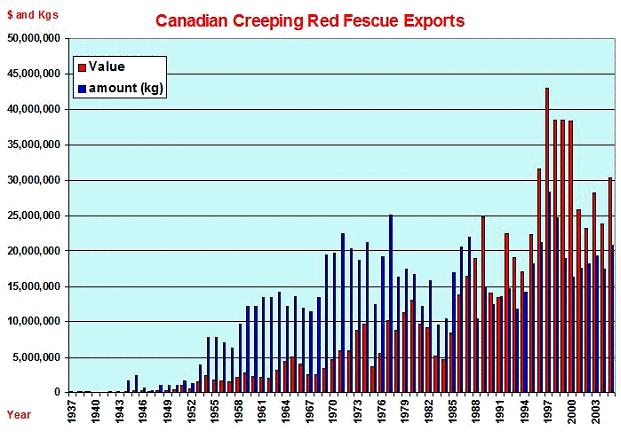
1960’s to present
Production of creeping red fescue seed continued to increase throughout the 1960’s and 70’s, first peaking in 1977, when over 55 million lbs. of creeping red fescue seed was exported. The driving force behind creeping red fescue demand continues to be the expanding turf seed market, especially in the US, where it is estimated the turf seed industry is a $40 billion market. Since the 1970’s, 1997 saw the largest amount of creeping red fescue exported (over 62 million lb.). Fescue seed exports over the past 20 years have averaged 39 million lbs./year. Major production changes included: bulk handling of seed, swathing of seed, solid seeding, improved herbicide availability to growers, and the building of a grass seed infrastructure within the region.
The production of creeping red fescue continues to focus on common seed. Annual acres of certified creeping red fescue (primarily the variety “Boreal”) over the past 20 years has averaged 17,000/year. This would constitute, on average, less than 20 per cent of total creeping red fescue acres. The USA remains the primary market place for creeping red fescue seed, and the fact that American buyers are not required to use certified seed in their turf grass mixtures results in the majority of Canadian growers growing common seed. Most certified Boreal seed is exported to Europe.
The production of creeping red fescue continues to focus on common seed. Annual acres of certified creeping red fescue (primarily the variety “Boreal”) over the past 20 years averages 17,000 acres/year. This would constitute, on average, less than 20 per cent of total creeping red fescue acres. The US remains the primary market place for creeping red fescue seed, and the fact that American buyers are not required to use certified seed in their turf grass mixtures, results in the majority of Canadian growers growing common seed. Most certified Boreal seed is exported to Europe.
Research
The majority of research associated with creeping red fescue has come out of the Agriculture Research Station at Beaverlodge, Alberta. Following in the footsteps of Dr. Earl Stacey came Dr. Bob Elliott, who arrived on the scene in Beaverlodge in 1952. Following Dr. Elliott’s retirement in the early 80’s, Dr. Nigel Fairey continued the research on creeping red fescue. Dr. Elliott is the breeder responsible for the commonly grown certified variety “Boreal”.
Early work included:
- rejuvenation of fescue stands through plowing
- floral induction
- fertilization trials, amounts and timing
- herbicide trials
Throughout the years, sub-stations located throughout the peace region have conducted research on creeping red fescue. The assistance of local producers helped these research projects be conducted and completed. Valuable data and practical management techniques were then passed onto local growers.
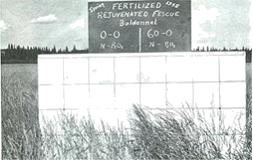
Fertilizer research on rejuvenated creeping red fescue, Baldonnel B.C. sub-station, 1957. Year following plowdown for rejuvenation, crop yielded 1200 lbs. /ac.
Buyers and Processors
Along with the growth of the fescue industry in the Peace region came the buyers and processors of creeping red fescue. Although many buyers were present in the region, most seed was transported out of the region for cleaning and processing. In the past, creeping red fescue was harvested and stored “rough” in 120-150 lb. jute bags. Buyers would congregate in the Peace region following fescue seed harvest and purchase seed, sampling bags for dockage and moisture. Many lots were bought at delivery points throughout the Peace region, and subsequently, transported out of the region for processing.
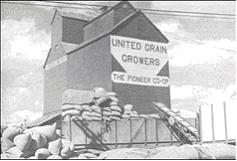
The UGG was a major buyer of rough creeping red fescue seed. (Beaverlodge Buying Station)
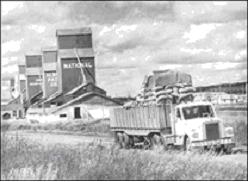
Truck loaded with jute bags of creeping red fescue seed headed for UGG’s processing plant in Edmonton.
The first local processing plant was built in 1952 in Beaverlodge by John Foster (Foster’s Seed and Feed). John Foster was not only a processor, but was a large grower of creeping red fescue seed. Foster’s Seed and Feed would give local growers another marketing outlet, as well as allow John Foster to clean and market his own seed.
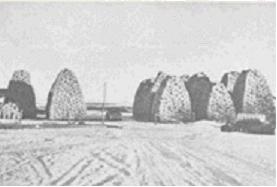
Sacks of creeping red fescue on the farm of John Foster. Each seed pile contained 45,000 lbs. of seed.
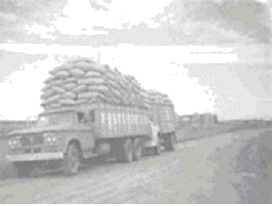
Trucks hauling fescue from John Fosters’ farm to his cleaning facility in Beaverlodge.
Expansion of grass seed processing facilities did not take place until the early 1970’s. Although buyers were plentiful, prices remained relatively low for quite a long time period. In 1970, the National Farmers’ Union (NFU) organized many growers to picket buying facilities, and not to deliver their fescue. This attempt to try and get higher prices resulted in injunctions against picketing farmers. However, the main after-shock from this action was many more companies getting involved in the grass seed business by setting up facilities in the Peace country. Many local processors, including Peace River Seed Coop, Brett Young Seeds, and Alberta Wheat Pool entered the grass seed processing picture in the early 1970’s.
A list of grass seed processors presenting operating in the Peace River region can be found at: Turf and Forage Seed Trade Companies Active in the Peace Region.
Summary
The Peace River region will continue to be the major producer of creeping red fescue seed in the world. With a climate suitable for good seed production, a well-established infrastructure, and growers willing and able to grow seed crops successfully, creeping red fescue will be visible in the Peace River region’s country side for generations to come. |
|